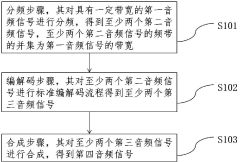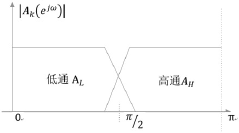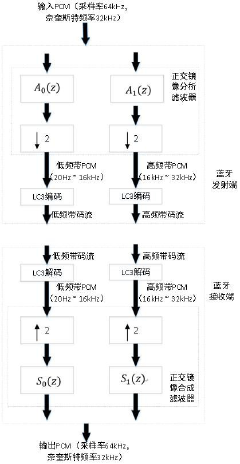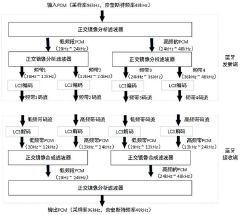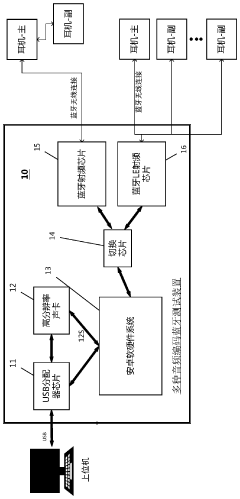How to Configure LDAC for High-Density Audio Data?
JUL 4, 20259 MIN READ
Generate Your Research Report Instantly with AI Agent
Patsnap Eureka helps you evaluate technical feasibility & market potential.
LDAC Technology Overview
LDAC (Low Latency Audio Codec) is a proprietary audio coding technology developed by Sony Corporation. It is designed to deliver high-resolution audio over Bluetooth connections, addressing the limitations of traditional Bluetooth audio codecs. LDAC supports audio transmission at up to 990 kbps, significantly higher than the standard SBC codec used in most Bluetooth devices.
The technology utilizes adaptive bit rate coding to optimize audio quality based on available bandwidth. It can operate in three modes: 330 kbps, 660 kbps, and 990 kbps, allowing for flexibility in different wireless environments. LDAC employs advanced signal processing techniques to minimize audio degradation during compression and transmission.
One of the key features of LDAC is its ability to maintain high-frequency content up to 40 kHz, preserving the full spectrum of high-resolution audio sources. This is achieved through a combination of efficient encoding algorithms and optimized data packaging methods.
LDAC also incorporates error correction and concealment techniques to ensure robust performance in challenging wireless conditions. These mechanisms help maintain audio quality even when faced with interference or signal degradation.
The codec is designed to be compatible with various audio formats, including PCM, DSD, and MQA. This versatility allows LDAC to support a wide range of high-resolution audio content, making it suitable for audiophile-grade applications.
LDAC has been widely adopted in the audio industry, with support from numerous smartphone manufacturers, audio equipment producers, and streaming services. Its integration into the Android operating system has further expanded its reach, making it accessible to a broad user base.
While LDAC offers significant improvements in audio quality over standard Bluetooth codecs, it does require compatible hardware on both the transmitting and receiving ends. This has led to a growing ecosystem of LDAC-enabled devices, including smartphones, headphones, speakers, and car audio systems.
The technology continues to evolve, with ongoing research focused on further reducing latency, improving energy efficiency, and enhancing compatibility with emerging wireless standards. As high-resolution audio becomes increasingly popular, LDAC plays a crucial role in bridging the gap between wired and wireless audio quality.
The technology utilizes adaptive bit rate coding to optimize audio quality based on available bandwidth. It can operate in three modes: 330 kbps, 660 kbps, and 990 kbps, allowing for flexibility in different wireless environments. LDAC employs advanced signal processing techniques to minimize audio degradation during compression and transmission.
One of the key features of LDAC is its ability to maintain high-frequency content up to 40 kHz, preserving the full spectrum of high-resolution audio sources. This is achieved through a combination of efficient encoding algorithms and optimized data packaging methods.
LDAC also incorporates error correction and concealment techniques to ensure robust performance in challenging wireless conditions. These mechanisms help maintain audio quality even when faced with interference or signal degradation.
The codec is designed to be compatible with various audio formats, including PCM, DSD, and MQA. This versatility allows LDAC to support a wide range of high-resolution audio content, making it suitable for audiophile-grade applications.
LDAC has been widely adopted in the audio industry, with support from numerous smartphone manufacturers, audio equipment producers, and streaming services. Its integration into the Android operating system has further expanded its reach, making it accessible to a broad user base.
While LDAC offers significant improvements in audio quality over standard Bluetooth codecs, it does require compatible hardware on both the transmitting and receiving ends. This has led to a growing ecosystem of LDAC-enabled devices, including smartphones, headphones, speakers, and car audio systems.
The technology continues to evolve, with ongoing research focused on further reducing latency, improving energy efficiency, and enhancing compatibility with emerging wireless standards. As high-resolution audio becomes increasingly popular, LDAC plays a crucial role in bridging the gap between wired and wireless audio quality.
Market Demand Analysis
The market demand for high-density audio data transmission has been steadily increasing, driven by the growing consumer appetite for high-quality audio experiences across various devices and platforms. LDAC, as a high-resolution audio codec developed by Sony, has positioned itself as a key player in meeting this demand. The technology's ability to transmit audio data at up to 990 kbps over Bluetooth connections has garnered significant attention from audiophiles and casual listeners alike.
In the smartphone market, there's a noticeable trend towards premium audio features, with manufacturers increasingly adopting LDAC support as a differentiator. This is particularly evident in the high-end and mid-range segments, where consumers are willing to pay a premium for superior audio quality. The integration of LDAC in flagship devices from major brands has created a ripple effect, pushing other manufacturers to follow suit to remain competitive.
The true wireless stereo (TWS) earbuds sector has seen explosive growth, with a compound annual growth rate (CAGR) exceeding 30% in recent years. As this market matures, there's a shift towards higher quality audio codecs like LDAC to cater to discerning users. This trend is expected to continue as consumers seek better audio experiences from their portable devices.
Home audio systems, including soundbars and wireless speakers, represent another significant market for LDAC technology. With the rise of high-resolution streaming services, there's an increasing demand for audio equipment capable of reproducing these high-quality streams faithfully. LDAC's ability to transmit near-lossless audio wirelessly makes it an attractive option for manufacturers looking to appeal to audiophiles and home theater enthusiasts.
The automotive industry is also showing interest in high-density audio codecs. As in-car entertainment systems become more sophisticated, there's a growing demand for high-quality audio streaming capabilities. LDAC's efficient transmission of high-resolution audio data makes it a compelling choice for automotive manufacturers aiming to enhance their in-vehicle audio experiences.
Professional audio equipment manufacturers are exploring LDAC integration for studio-grade wireless monitoring solutions. This niche market segment values the codec's ability to transmit high-quality audio with minimal latency, which is crucial for live performance and recording scenarios.
The global pandemic has accelerated the adoption of remote work and virtual collaboration tools, indirectly boosting the demand for high-quality audio solutions. As video conferencing becomes a staple in both professional and personal settings, there's an increased focus on audio quality, potentially opening new avenues for LDAC application in communication devices and software.
While the market demand for LDAC and similar high-density audio technologies is growing, it's important to note that challenges remain. These include compatibility issues with older devices, the need for consumer education on the benefits of high-resolution audio, and competition from other emerging audio codecs. However, the overall trend suggests a positive outlook for LDAC and high-density audio technologies in the coming years.
In the smartphone market, there's a noticeable trend towards premium audio features, with manufacturers increasingly adopting LDAC support as a differentiator. This is particularly evident in the high-end and mid-range segments, where consumers are willing to pay a premium for superior audio quality. The integration of LDAC in flagship devices from major brands has created a ripple effect, pushing other manufacturers to follow suit to remain competitive.
The true wireless stereo (TWS) earbuds sector has seen explosive growth, with a compound annual growth rate (CAGR) exceeding 30% in recent years. As this market matures, there's a shift towards higher quality audio codecs like LDAC to cater to discerning users. This trend is expected to continue as consumers seek better audio experiences from their portable devices.
Home audio systems, including soundbars and wireless speakers, represent another significant market for LDAC technology. With the rise of high-resolution streaming services, there's an increasing demand for audio equipment capable of reproducing these high-quality streams faithfully. LDAC's ability to transmit near-lossless audio wirelessly makes it an attractive option for manufacturers looking to appeal to audiophiles and home theater enthusiasts.
The automotive industry is also showing interest in high-density audio codecs. As in-car entertainment systems become more sophisticated, there's a growing demand for high-quality audio streaming capabilities. LDAC's efficient transmission of high-resolution audio data makes it a compelling choice for automotive manufacturers aiming to enhance their in-vehicle audio experiences.
Professional audio equipment manufacturers are exploring LDAC integration for studio-grade wireless monitoring solutions. This niche market segment values the codec's ability to transmit high-quality audio with minimal latency, which is crucial for live performance and recording scenarios.
The global pandemic has accelerated the adoption of remote work and virtual collaboration tools, indirectly boosting the demand for high-quality audio solutions. As video conferencing becomes a staple in both professional and personal settings, there's an increased focus on audio quality, potentially opening new avenues for LDAC application in communication devices and software.
While the market demand for LDAC and similar high-density audio technologies is growing, it's important to note that challenges remain. These include compatibility issues with older devices, the need for consumer education on the benefits of high-resolution audio, and competition from other emerging audio codecs. However, the overall trend suggests a positive outlook for LDAC and high-density audio technologies in the coming years.
LDAC Technical Challenges
LDAC, as a high-resolution audio codec, faces several technical challenges in its implementation and optimization for high-density audio data. One of the primary challenges is achieving the optimal balance between audio quality and transmission efficiency. LDAC operates at variable bit rates, ranging from 330 kbps to 990 kbps, and configuring these rates to match the audio content and available bandwidth is crucial for maintaining high-quality audio reproduction.
The codec's complexity presents another significant challenge. LDAC employs sophisticated algorithms for audio compression and decompression, which require substantial computational resources. This can lead to increased power consumption and potential latency issues, especially in portable devices with limited processing capabilities. Optimizing these algorithms for various hardware configurations while maintaining audio fidelity is an ongoing challenge for developers.
Bluetooth transmission stability is a critical factor affecting LDAC performance. The codec relies on a stable Bluetooth connection to transmit large amounts of audio data. However, environmental interference, device limitations, and signal obstructions can disrupt this connection, potentially causing audio dropouts or quality degradation. Developing robust error correction and packet loss concealment techniques is essential to mitigate these issues.
Compatibility across different devices and platforms poses another challenge for LDAC implementation. While the codec is becoming more widely adopted, ensuring seamless integration and consistent performance across various smartphones, audio receivers, and wireless headphones requires extensive testing and optimization. This includes addressing differences in hardware capabilities, operating systems, and audio processing chains.
The dynamic nature of audio content adds complexity to LDAC configuration. Different types of audio material, from classical music to podcasts, have varying spectral characteristics and dynamic ranges. Configuring LDAC to adapt to these diverse audio sources while maintaining optimal quality and efficiency is a nuanced task that requires sophisticated analysis and adjustment algorithms.
Latency management is crucial, especially for applications requiring real-time audio processing, such as gaming or live performances. LDAC's high bit rates and complex processing can introduce noticeable delays. Minimizing this latency while preserving audio quality is a delicate balance that engineers must strike through careful codec optimization and buffer management.
Lastly, power efficiency remains a significant challenge, particularly for battery-powered devices. The high data rates and processing demands of LDAC can lead to increased power consumption. Developing energy-efficient implementations that can deliver high-quality audio without significantly impacting battery life is an ongoing area of research and development in the field of high-density audio codecs.
The codec's complexity presents another significant challenge. LDAC employs sophisticated algorithms for audio compression and decompression, which require substantial computational resources. This can lead to increased power consumption and potential latency issues, especially in portable devices with limited processing capabilities. Optimizing these algorithms for various hardware configurations while maintaining audio fidelity is an ongoing challenge for developers.
Bluetooth transmission stability is a critical factor affecting LDAC performance. The codec relies on a stable Bluetooth connection to transmit large amounts of audio data. However, environmental interference, device limitations, and signal obstructions can disrupt this connection, potentially causing audio dropouts or quality degradation. Developing robust error correction and packet loss concealment techniques is essential to mitigate these issues.
Compatibility across different devices and platforms poses another challenge for LDAC implementation. While the codec is becoming more widely adopted, ensuring seamless integration and consistent performance across various smartphones, audio receivers, and wireless headphones requires extensive testing and optimization. This includes addressing differences in hardware capabilities, operating systems, and audio processing chains.
The dynamic nature of audio content adds complexity to LDAC configuration. Different types of audio material, from classical music to podcasts, have varying spectral characteristics and dynamic ranges. Configuring LDAC to adapt to these diverse audio sources while maintaining optimal quality and efficiency is a nuanced task that requires sophisticated analysis and adjustment algorithms.
Latency management is crucial, especially for applications requiring real-time audio processing, such as gaming or live performances. LDAC's high bit rates and complex processing can introduce noticeable delays. Minimizing this latency while preserving audio quality is a delicate balance that engineers must strike through careful codec optimization and buffer management.
Lastly, power efficiency remains a significant challenge, particularly for battery-powered devices. The high data rates and processing demands of LDAC can lead to increased power consumption. Developing energy-efficient implementations that can deliver high-quality audio without significantly impacting battery life is an ongoing area of research and development in the field of high-density audio codecs.
Current LDAC Configurations
01 LDAC codec for high-quality audio transmission
LDAC is a high-resolution audio codec developed for Bluetooth audio transmission. It allows for higher data transfer rates and improved audio quality compared to standard Bluetooth codecs. LDAC supports various sampling rates and bit depths, enabling the transmission of high-resolution audio content wirelessly.- LDAC codec for high-resolution audio transmission: LDAC is a high-quality audio codec developed for Bluetooth audio transmission. It allows for higher data density in audio streaming, enabling the transmission of high-resolution audio content wirelessly. The codec supports various bit rates and sampling frequencies, providing flexibility in audio quality and transmission efficiency.
- Data compression and encoding techniques for audio: Various data compression and encoding techniques are employed to increase audio data density while maintaining quality. These methods include advanced algorithms for reducing file sizes, optimizing bit allocation, and enhancing the efficiency of audio data transmission and storage.
- Audio data management and storage systems: Efficient audio data management and storage systems are crucial for handling high-density audio data. These systems involve specialized file structures, data organization methods, and storage techniques to optimize the handling of large audio files and streams, particularly in the context of high-resolution audio.
- Signal processing for audio quality enhancement: Advanced signal processing techniques are used to enhance audio quality and increase perceived data density. These methods include noise reduction, dynamic range compression, and frequency response optimization, which contribute to improved audio fidelity in high-density audio formats.
- Audio data transmission protocols and interfaces: Specialized protocols and interfaces are developed for transmitting high-density audio data. These include improvements in Bluetooth audio transmission, USB audio interfaces, and other digital audio interconnects, focusing on increasing bandwidth and reducing latency for high-quality audio streaming.
02 Audio data compression and encoding techniques
Various compression and encoding techniques are employed to optimize audio data density while maintaining quality. These methods include advanced algorithms for reducing file size, efficient encoding schemes, and adaptive bit rate allocation to preserve critical audio information.Expand Specific Solutions03 Audio data storage and management systems
Efficient storage and management of audio data are crucial for maintaining high data density. This includes optimized file systems, data organization techniques, and storage architectures designed specifically for audio content, allowing for quick access and retrieval of audio files.Expand Specific Solutions04 Audio signal processing for enhanced data density
Advanced signal processing techniques are applied to audio data to improve its density and quality. This includes methods for noise reduction, dynamic range compression, and spectral analysis to optimize the audio signal before encoding or transmission.Expand Specific Solutions05 Integration of audio data in multimedia systems
The integration of high-density audio data in multimedia systems requires specialized techniques for synchronization, buffering, and playback. This involves methods for efficient handling of audio streams alongside other media types, ensuring seamless playback and optimal use of system resources.Expand Specific Solutions
Key LDAC Industry Players
The LDAC high-density audio configuration market is in a growth phase, driven by increasing demand for high-quality wireless audio experiences. The market size is expanding as more devices adopt this technology, particularly in premium audio products. Technologically, LDAC is relatively mature, with key players like Sony, the technology's developer, leading implementation. Companies such as Qualcomm, MediaTek, and Huawei are also actively involved in integrating LDAC support into their chipsets and devices. While Sony maintains a strong position due to its proprietary nature, other major semiconductor and consumer electronics companies are contributing to wider adoption and continued refinement of LDAC technology across various audio devices and platforms.
QUALCOMM, Inc.
Technical Solution: Qualcomm's approach to high-density audio data transmission focuses on their aptX HD and aptX Adaptive codecs, which compete with LDAC. While not directly configuring LDAC, Qualcomm's solution addresses similar challenges. The aptX Adaptive codec dynamically adjusts bit rate and audio quality based on the content type and RF environment, supporting up to 24-bit/48kHz audio[4]. Qualcomm has implemented a scalable architecture that allows for bitrates between 279kbps and 420kbps, balancing high-quality audio with efficient power usage[5]. Their system also includes active monitoring of RF conditions to maintain a stable connection, crucial for high-density audio streaming.
Strengths: Dynamic adaptation to content and RF conditions; lower latency compared to LDAC; wide device compatibility. Weaknesses: Lower maximum bitrate than LDAC; requires Qualcomm chipsets for optimal performance.
MediaTek, Inc.
Technical Solution: MediaTek has focused on developing audio solutions that support high-density audio data transmission, including compatibility with LDAC. Their approach involves integrating support for multiple high-resolution audio codecs into their chipsets, allowing device manufacturers to implement LDAC and other advanced audio technologies easily. MediaTek's Dimensity series of 5G SoCs includes native support for LDAC, enabling high-quality Bluetooth audio streaming[8]. The company has also developed its own audio processing technology, called Pump Express Audio, which works in conjunction with high-resolution codecs to enhance audio quality and power efficiency[9].
Strengths: Wide codec support including LDAC; integrated solutions for easy implementation; focus on power efficiency. Weaknesses: Reliance on third-party codec technologies; less control over codec development compared to proprietary solutions.
LDAC Core Innovations
A method and system for realizing high sampling rate audio coding and decoding
PatentActiveCN111986685B
Innovation
- The audio signal is divided into multiple frequency bands through the frequency division step, each frequency band is encoded and decoded using a standard codec, and the encoded and decoded signals are synthesized through the synthesis step to achieve high sampling rate audio encoding and decoding. Specific methods include using an orthogonal image analysis filter to divide the audio signal, multiple LC3 audio codecs to encode and decode the divided signal, and finally synthesizing it through an orthogonal image synthesis filter to increase the sampling rate.
Device and method for testing various audio codes of Bluetooth headset
PatentActiveCN111313984A
Innovation
- A test device including a USB distributor, Android software and hardware system, high-resolution sound card and switching chip is used. The Android software and hardware system controls the switching chip to select a Bluetooth radio frequency chip or a Bluetooth LE radio frequency chip for audio signal transmission, and supports multiple encoding formats. Such as SBC, aptX, LDAC, HWA and LC3 testing.
LDAC Compatibility Issues
LDAC compatibility issues primarily stem from the technology's advanced nature and specific hardware requirements. As a high-resolution audio codec developed by Sony, LDAC aims to deliver exceptional audio quality over Bluetooth connections. However, this advanced capability comes with certain limitations and compatibility challenges.
One of the main compatibility issues is device support. LDAC requires both the transmitting device (e.g., smartphone or audio player) and the receiving device (e.g., headphones or speakers) to support the codec. While LDAC has been integrated into Android devices since version 8.0 (Oreo), many older Android devices and most iOS devices do not support it natively. This creates a significant barrier for widespread adoption and limits the potential user base.
Another compatibility challenge lies in the implementation of LDAC across different manufacturers. Although Sony has made LDAC available to other companies, the integration and optimization of the codec can vary. This can lead to inconsistent performance and compatibility issues between devices from different brands, even if they technically support LDAC.
The codec's high bitrate requirements also pose compatibility challenges with existing Bluetooth hardware. LDAC operates at bitrates up to 990 kbps, which is significantly higher than standard Bluetooth audio codecs. This demands more from the Bluetooth chipsets and antennas in both transmitting and receiving devices. Older or lower-end devices may struggle to maintain a stable connection or achieve the full potential of LDAC's audio quality.
Furthermore, LDAC's adaptive bitrate feature, while beneficial for maintaining connection stability, can introduce compatibility issues. The codec can switch between different bitrates (330 kbps, 660 kbps, and 990 kbps) based on connection quality. However, some devices may not handle these transitions smoothly, leading to audio dropouts or inconsistent quality.
Compatibility with various audio file formats and streaming services also presents challenges. While LDAC supports high-resolution audio, not all music sources provide content at the necessary quality level to fully utilize LDAC's capabilities. This mismatch between codec potential and available content can lead to confusion and disappointment among users.
Lastly, the complexity of configuring LDAC settings on both transmitting and receiving devices can create user experience issues. The multiple bitrate options and the need for manual configuration in some cases may be overwhelming for less tech-savvy users, potentially limiting LDAC's adoption among the general consumer base.
One of the main compatibility issues is device support. LDAC requires both the transmitting device (e.g., smartphone or audio player) and the receiving device (e.g., headphones or speakers) to support the codec. While LDAC has been integrated into Android devices since version 8.0 (Oreo), many older Android devices and most iOS devices do not support it natively. This creates a significant barrier for widespread adoption and limits the potential user base.
Another compatibility challenge lies in the implementation of LDAC across different manufacturers. Although Sony has made LDAC available to other companies, the integration and optimization of the codec can vary. This can lead to inconsistent performance and compatibility issues between devices from different brands, even if they technically support LDAC.
The codec's high bitrate requirements also pose compatibility challenges with existing Bluetooth hardware. LDAC operates at bitrates up to 990 kbps, which is significantly higher than standard Bluetooth audio codecs. This demands more from the Bluetooth chipsets and antennas in both transmitting and receiving devices. Older or lower-end devices may struggle to maintain a stable connection or achieve the full potential of LDAC's audio quality.
Furthermore, LDAC's adaptive bitrate feature, while beneficial for maintaining connection stability, can introduce compatibility issues. The codec can switch between different bitrates (330 kbps, 660 kbps, and 990 kbps) based on connection quality. However, some devices may not handle these transitions smoothly, leading to audio dropouts or inconsistent quality.
Compatibility with various audio file formats and streaming services also presents challenges. While LDAC supports high-resolution audio, not all music sources provide content at the necessary quality level to fully utilize LDAC's capabilities. This mismatch between codec potential and available content can lead to confusion and disappointment among users.
Lastly, the complexity of configuring LDAC settings on both transmitting and receiving devices can create user experience issues. The multiple bitrate options and the need for manual configuration in some cases may be overwhelming for less tech-savvy users, potentially limiting LDAC's adoption among the general consumer base.
LDAC Performance Metrics
LDAC performance metrics are crucial for evaluating the effectiveness of this high-resolution audio codec developed by Sony. These metrics provide insights into the codec's ability to deliver high-quality audio over Bluetooth connections while maintaining efficiency and compatibility.
One of the primary performance metrics for LDAC is its variable bitrate capability. LDAC supports three different bitrates: 330 kbps, 660 kbps, and 990 kbps. This flexibility allows the codec to adapt to different network conditions and device capabilities, ensuring optimal audio quality across various scenarios. The highest bitrate of 990 kbps is particularly noteworthy, as it enables near-lossless audio transmission, surpassing the capabilities of many other Bluetooth audio codecs.
Another important metric is LDAC's frequency response range. The codec can handle audio frequencies up to 96 kHz, which is significantly higher than the human auditory range and exceeds the capabilities of most consumer audio equipment. This extended frequency response ensures that even the most subtle high-frequency details in audio recordings are preserved during transmission.
LDAC's support for high-resolution audio formats is also a key performance indicator. The codec can handle audio with up to 32-bit depth and 96 kHz sampling rate, allowing for the transmission of studio-quality audio files without significant loss of information. This capability is particularly valuable for audiophiles and professionals who demand the highest level of audio fidelity.
Latency is another critical metric for LDAC performance. While Bluetooth audio codecs generally introduce some delay, LDAC's latency is relatively low compared to other high-quality codecs. This low latency is essential for maintaining synchronization between audio and video content, making LDAC suitable for applications such as gaming and video streaming.
Power efficiency is an often-overlooked but crucial performance metric for any Bluetooth codec. LDAC's ability to deliver high-quality audio while maintaining reasonable power consumption is a significant factor in its adoption by device manufacturers. The codec's efficiency helps extend battery life in portable devices, striking a balance between audio quality and energy consumption.
Compatibility and device support are also important metrics for assessing LDAC's performance in real-world scenarios. The codec's integration into the Android operating system and support from various audio equipment manufacturers contribute to its widespread adoption and practical usability.
One of the primary performance metrics for LDAC is its variable bitrate capability. LDAC supports three different bitrates: 330 kbps, 660 kbps, and 990 kbps. This flexibility allows the codec to adapt to different network conditions and device capabilities, ensuring optimal audio quality across various scenarios. The highest bitrate of 990 kbps is particularly noteworthy, as it enables near-lossless audio transmission, surpassing the capabilities of many other Bluetooth audio codecs.
Another important metric is LDAC's frequency response range. The codec can handle audio frequencies up to 96 kHz, which is significantly higher than the human auditory range and exceeds the capabilities of most consumer audio equipment. This extended frequency response ensures that even the most subtle high-frequency details in audio recordings are preserved during transmission.
LDAC's support for high-resolution audio formats is also a key performance indicator. The codec can handle audio with up to 32-bit depth and 96 kHz sampling rate, allowing for the transmission of studio-quality audio files without significant loss of information. This capability is particularly valuable for audiophiles and professionals who demand the highest level of audio fidelity.
Latency is another critical metric for LDAC performance. While Bluetooth audio codecs generally introduce some delay, LDAC's latency is relatively low compared to other high-quality codecs. This low latency is essential for maintaining synchronization between audio and video content, making LDAC suitable for applications such as gaming and video streaming.
Power efficiency is an often-overlooked but crucial performance metric for any Bluetooth codec. LDAC's ability to deliver high-quality audio while maintaining reasonable power consumption is a significant factor in its adoption by device manufacturers. The codec's efficiency helps extend battery life in portable devices, striking a balance between audio quality and energy consumption.
Compatibility and device support are also important metrics for assessing LDAC's performance in real-world scenarios. The codec's integration into the Android operating system and support from various audio equipment manufacturers contribute to its widespread adoption and practical usability.
Unlock deeper insights with Patsnap Eureka Quick Research — get a full tech report to explore trends and direct your research. Try now!
Generate Your Research Report Instantly with AI Agent
Supercharge your innovation with Patsnap Eureka AI Agent Platform!
